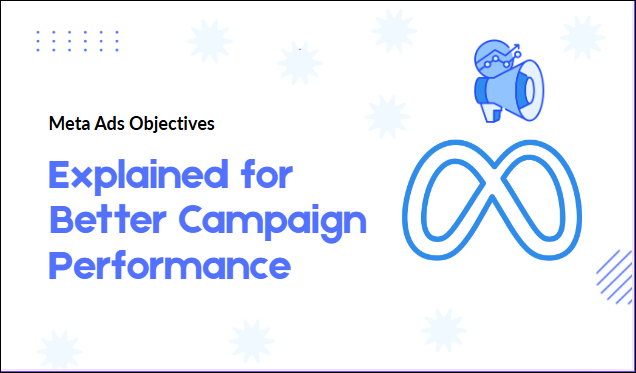Introduction
Meta Ads (formerly Facebook Ads) offers a wide range of powerful tools for advertising on social media that are meant to help businesses meet their marketing goals. No matter how big or small your business is, knowing how to pick and use the right ad goals may make or break your campaign. As a leading digital marketing company in Chennai, we know from experience that tailoring your Meta Ads goals to your specific goals increases engagement, spending efficiency, and, ultimately, return on ad spend (ROAS). This guide will help you learn about the different Meta Ads goals and show you how to use them to get the most out of your campaign.
Understanding the Goals of Meta Ads
Meta Ads objectives are the goals you define for your ad campaigns. The first step in making an ad in Meta’s Ads Manager is to choose a goal that fits with what you want to achieve. Then, Meta makes sure that the people who are most likely to do that see your ad. The goals fall into three main groups:
- Awareness: Make people want to know more about what you have to offer.
- Consideration: Get people to think about your business and look for more information.
- Conversion: Get people to do things that are good for them, like buy something, sign up, or visit.
Meta’s algorithm will focus on people who are most likely to finish the task if you choose the proper goal. This will make it more effective and improve performance.
Goals for Awareness
Awareness goals are great if your main goal is to get in front of as many relevant people as possible. Some of them are:
- Brand Awareness: Puts your ads in front of the people who are most likely to remember them first.
- Reach: Tries to obtain the most unique people to see your ad while staying within your budget.
Use awareness objectives when you want to launch a new product, get more people to know about your brand, or enter a new market. For example, when you start a seasonal sale, a Reach campaign can quickly and cheaply reach the people you want to reach. These goals are especially useful for creating top-of-funnel presence before sending customers to deeper engagement or conversion.
Things to Think About
Consideration goals help you keep people’s attention and get them to look more closely at what you have to offer after you’ve gotten their attention. Some of the options in this group are:
- Traffic: This is what gets users to your app, blog, or website.
- Engagement: Encourages interactions such as comments, likes, shares, and reactions to events.
- App Installs: This takes consumers to the page where they may download your mobile app.
- Video Views: Getting people to watch your video material is more likely if you promote it.
- Lead Generation: Getting user data directly from Facebook or Instagram forms is part of lead generation.
- Messages: Starts a conversation on WhatsApp or Messenger, which is great for one-on-one communication.
The consideration objectives are what keeps the funnel going in the middle. A Lead Generation campaign is a great way to get phone numbers or email addresses for follow-up, and a video view campaign might show off the benefits of a product. At this phase, you can give prospects useful information to warm them up and get them ready for conversion-focused activities.
Goals for Conversion
If you want to get people to do things that are good for them, like buy something or sign up, conversion goals should be your main focus. Some of the options are:
- Conversions: The SDK or Meta Pixel keeps track of these and customizes them for actions on your website or app.
- Catalog Sales: Sends automatic ads for products from your e-commerce catalog to customers who are likely to buy them.
- Store Traffic: Uses information about how close a business is to a person’s home and where they live to encourage them to visit in person.
Setting up conversion events and installing the Meta Pixel on your website are two important parts of a good tracking setup for conversion goals. Once it is set up, Meta’s algorithm figures out which users are most likely to convert and changes how ads are sent. Service-based businesses might focus on filling out forms or setting up appointments, but e-commerce companies’ catalog sales efforts show products with ads that are relevant to them.
Choosing the Right Campaign Goal
To make your campaign work, you need to make sure that the right Meta Ads goal matches your business goals. Do these things:
- Set your goal: Do you want to make direct sales, get more people to visit your website, or raise awareness?
- Map to Funnel Stage: Follow the steps of the client journey for awareness, consideration, or conversion.
- Choose the goal: In Ads Manager, use steps 1 and 2 to make your choice.
- Set clear KPIs: Pick metrics (CPM, CTR, CPC, and CPA) to see how far you’ve come toward your objective.
For example, a new product launch might start with ads that raise brand recognition, then move on to ads that drive people to a product page, and lastly ads that show buy events. This way of stacking goals makes it easy to get from discovery to choice.
The Best Ways to Run Campaigns Based on Goals Better
To get the most out of your chosen goals, use these best practices:
- Creatively Adapted to the Goal: Use eye-catching images to get people to pay attention, instructional movies to get them to think about it, and clear calls to action to get them to take action.
- Use audience segmentation to create different groups of people at each stage of the funnel, such as warm audiences who have interacted with your brand and cold audiences who haven’t.
- Budget Allocation: Give money to the most important parts of the organization; once you’ve raised awareness, spend enough on activities that lead to conversions.
- A/B Testing: You should always use A/B testing to check your ad copy, pictures, and placements. Change your ads every seven to ten days to keep people from getting tired of them.
- Bid Strategy: Choose between manual cost restrictions and automatic bidding based on how well you do and how much you want to spend.
- Ad Frequency Management: Keep an eye on frequency metrics to make sure your ads don’t get too much exposure, which can lead to higher costs and ad fatigue.
Following these best practices will help you make sure that each campaign is well suited to its aim, which will make it more effective and cost-efficient.
Evaluating and Making Changes to Boost Performance
After your campaigns are live, you need to measure and change them over time to make sure they work. Listen to these things:
- Keep an eye on the metrics that are important to the goal
- Awareness: Increase in ad recall, impressions, and reach (objective for brand awareness)
- Consideration: We look at both the Click-Through Rate (CTR) and the Cost per Link Click (CPC)
- Conversion: Cost per Action (CPA), Return on Ad Spend (ROAS), and Conversion Rate
- Awareness: Increase in ad recall, impressions, and reach (objective for brand awareness)
- Look at the audience data
Use Meta’s analysis to see which placements and demographics work best. - Make Bad Ads Better
You should stop running ads that have a poor CTR or a high CPA. Send money to employees who do well. - Use Successful Methods Longer
To keep cost metrics steady, raise the budget for ad sets that are doing well by 10% to 20% over time. - Wash and Repeat
Campaigns stay in pace with evolving customer preferences and industry advancements by constantly learning and adapting.
Regular reviews and changes based on data make sure that your Meta Ads are always working toward the goals you set.
To Sum Up
More than just campaign settings, Meta’s ad objectives are strategic levers that tell Meta’s algorithm when and to whom to show your ads. By understanding and properly applying Awareness, Consideration, and Conversion goals, you can boost engagement, get the most out of your ad spending, and see measurable business results. Don’t forget to utilize best practices for targeting and creative, make sure your campaign goals meet the correct aim, and measure your outcomes often so you can do better. No matter how big or small your business is, understanding Meta Ads goals is important for getting better results from your campaigns and growing in competitive online markets. If you’re interested in digital marketing in Chennai, these tips will help you get your campaigns off to a good start.


